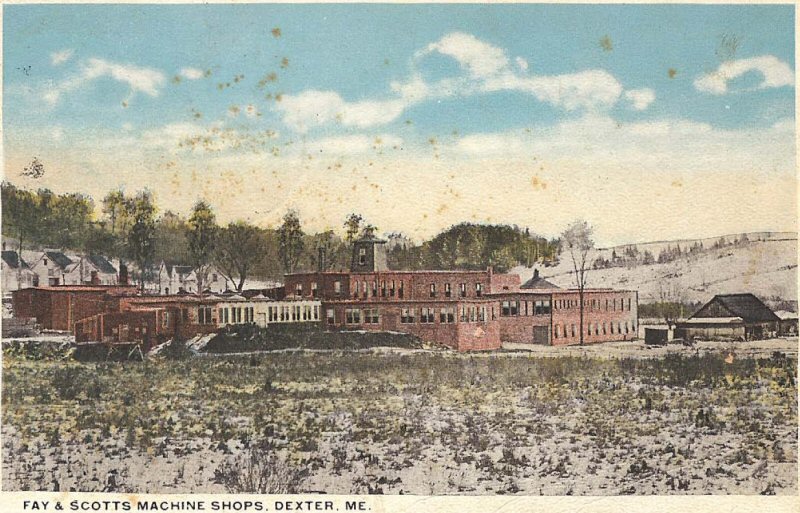Fay & Scott was founded in 1881 by Norman H. Fay and Walter Scott. The two were shopmates, employed as mechanics, when they began renting a part of the shop they were working in and begin the firm Fay & Scott. Scott retired in 1896 and Fay purchased his interest in the company, but retained the firm name of Fay & Scott.
In 1884, a new plant and foundry was constructed on the site of the former Copeland Woolen Mill, which had burned in 1868. Barely before they were settled in this new building, they were forced to enlarge the shops due to their work load. Most sources state that the company was incorporated in 1901, although, some sources state 1900.

The company's initial products were wood-turning lathes used to make peavey handles for the local logging industry. Eventually, the shop expanded into engine (metal) lathes, pattern making lathes, and a wide variety of contracted machines for American industry. A Fay & Scott lathe was on the battleship Maine when it sank in Havana Harbor. The Navy sent the lathe back to Fay & Scott to be reconditioned when it was salvaged from the wreck. Fay & Scott went on to produce a large amount of war ordinance for the U.S. military
during World Wars I.
During WWII, Fay & Scott did major retooling of its factory to make much needed items for war production, including various kinds of ordinance and the famous M7 Grenade Launcher. Their HK extensible-bed engine lathe was also in demand—enough so that Smith, Drum & Co. was apparently provided with the plans so that they could also make that lathe design.
When the war was over, the company struggled to keep their doors open. On July 16, 1947 when the company and factory was purchased by textile-machinery maker Whitin Machine Works, and the Fay-Scott plant was reorganized as a subsidiary under the name Fayscott Corp. During this period, in addition to textile machinery, Whitin used the foundry and machine shops in Dexter to diversify their manufacturing capabilities to include items outside of their traditional line of textile machines, including Airfoil grinders for Pratt and Whitney, heavy castings for the Atomic Energy Commission and even missiles for the U.S. Army.
Whitin continued to operate the factory in Dexter until 1966 when Whitin was purchased by White Consolidated Industries, and the old factory was used to manufacturer various machine tools including Leland-Gifford branded drill presses. In 1986 White made the decision to quit manufacturing machine tools and the subsidiary was sold to local owners who continued to operate it until 2001, when it was sold again and reorganized to became Fayscott, LLC. The new venture was ultimately unsuccessful and permanently shut down in May, 2003.
Check out the UK lathes site for more history.
Information Sources
- Mentioned in October 1883 issue of Manufacturer & Builder, in an article on exhibitors at the New England Manufacturers' and Mechanics' Institute Fair: "From Fay & Scott, of Dexter, Me., pattern makers’ lathes, the special feature of which is a sliding carriage the whole length of the bed. They also show their hand lathes."
- The July 1884 issue of Manufacturer & Builder says, "Fay & Scott, Dexter, Me., have been adding many tools to their plant, and are building a new shop and foundry, both of brick. The former is 40 by 50 feet, two stories; the latter, 30 by 80 feet."
- Mentioned in the March 1885 issue of Manufacturer & Builder as exhibiting their lathes at the New Orleans Exhibition.
- A two page article on Fay & Scott appeared in the Jan. 1899 edition of Machinery which included a brief history of the beginnings of the company.
- The Dexter Main Historical Society has some basic history of Fay & Scott as well as a few photographs on their web site.
- The August 4, 1904 issue of The Eastern Gazette included a historical souvenir supplement on Dexter, Maine, which included an article titled The Early History of the Town of Dexter by Halcyon Chase. In the portion of this history devoted to Fay & Scott, the article states: "The seedling plant was located in a portion of the Dustin block until 1884, when the present plant which is comprised in a machine shop 300 x 50 and a foundry 130 x 80. The former is divided by a tower projection enclosing the main entrance with a jutting alcove opposite, amply lighted upon three sides, and within which are the general offices." The article went on to state: "Employment is furnished ninety-five mechanics of all grads, the weekly payroll approximating $1000."
- An interesting insight to working in the Fay & Scott Foundry in the 1930's through 1940's can by found in this recollection titled Fay Scott Foundry, by Fred Wintle, dated November 11, 2002
- Greg Menke put together a collection of historical photographs from the Fay & Scott company obtained from the Dexter Historical Society, Dexter ME. View here: Fay & Scott Company, Dexter ME
- YouTube video on rebuilding a Fay & Scott Patternmakers lathe compound slide.
- More history and machine information can be found at Tony Griffith's Lathe web site.
- 1919 Fay & Scott Engine Lathes catalogue.